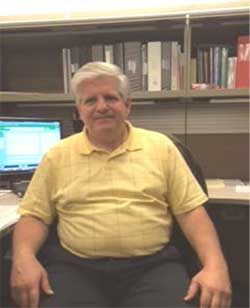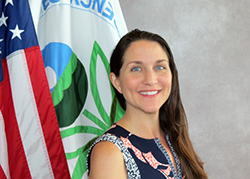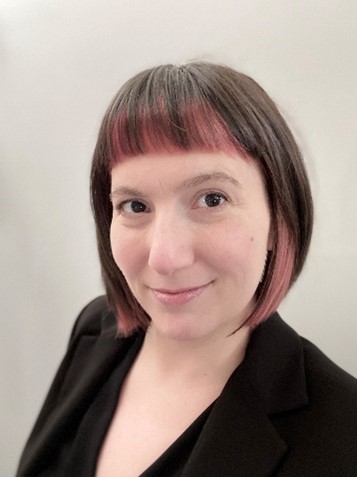FRTR Presents...Evolution of Subsurface Remediation: Lessons Learned from Technical Challenges to Achieving Cleanup Goals - Part 2
Sponsored by: Federal Remediation Technologies Roundtable (FRTR)
Archived: Wednesday, October 17, 2018
FRTR Presents...Evolution of Subsurface Remediation: Lessons Learned from Technical Challenges to Achieving Cleanup Goals - Part 2
2018-10-17
Federal Remediation Technologies Roundtable (FRTR)
This is a two-part webinar series featuring presentations delivered at the Spring 2018 FRTR Meeting. The meeting's goals were to identify and discuss case studies where remediation technologies were successful for a variety of soil and groundwater systems; and to share experiences and lessons learned that contributed to the operation of these successful remediation technologies.
- Lessons Learned from the Desktop Optimization Effort for FUDS and the Army
- Lessons Learned Applying Multiple Remediation Technologies at Air Force Plant 4
- DOE-EM Soil and Water Assistance Team: Technical Support to Complex Sites
Upcoming FRTR Presents Series Webinars
FRTR Presents Series Archives
- FRTR Spring 2025 General Meeting: Innovative Approaches to Characterization and Survey of Complex Mixtures of Contaminants in Support of End-State Regulatory Compliance (Session 2 - Technologies) (May 14, 2025)
- FRTR Spring 2025 General Meeting: Innovative Approaches to Characterization and Survey of Complex Mixtures of Contaminants in Support of End-State Regulatory Compliance (Session 1 - Strategies) (May 13, 2025)
- FRTR Presents ... TRAC — A Tool for Tracking Groundwater Restoration Across Multiple Sites (Dec 4, 2024)
- FRTR Fall 2024 General Meeting: Source Differentiation and Risk Assessments for Sites Impacted by PFAS (Oct 29, 2024)
- FRTR Spring 2024 General Meeting: Artificial Intelligence and Machine Learning to Optimize Site Remediation (May 21, 2024)
- FRTR Presents...Recent Advances in PFAS Characterization Technologies (Feb 28, 2024)
- FRTR Fall 2023 General Meeting: Recent Advances in PFAS Characterization Technologies (Nov 7, 2023)
- FRTR Spring 2023 General Meeting: Best Practices and Recent Technical Advances in Site Characterization and Conceptual Site Model Development (May 16, 2023)
- Application of Robotics, Machine Learning and Artificial Intelligence Technologies to Site Remediation (Jun 13, 2022)
- Application of Robotics, Machine Learning and Artificial Intelligence Technologies to Site Remediation (Jun 6, 2022)
- FRTR Fall 2021 Meeting, Two Part Series on Remedy Protectiveness and Climate Resilience in Site Cleanups: Session 2 (Nov 15, 2021)
- FRTR Fall 2021 Meeting, Two Part Series on Remedy Protectiveness and Climate Resilience in Site Cleanups: Session 1 (Nov 8, 2021)
- FRTR at 30 Years: Grand Challenges and Opportunities for Advancing Remediation Technologies, Session 2 (May 26, 2021)
- FRTR at 30 Years: Grand Challenges and Opportunities for Advancing Remediation Technologies, Session 1 (May 19, 2021)
- FRTR at 30 Years: A Retrospective of Applied Innovative Technologies for Successful Site Remediation (Nov 18, 2020)
- FRTR Spring 2020 Meeting, Session 2: Bioremediation Advances - New Strategies, Optimization, and Performance Monitoring (Jun 5, 2020)
- FRTR Spring 2020 Meeting, Session 1: Bioremediation Advances - New Strategies, Optimization, and Performance Monitoring (May 29, 2020)
- FRTR Presents...Synthesizing Evolving Conceptual Site Models (CSMs) with Applicable Remediation Technologies (Apr 1, 2020)
- FRTR Presents...Modeling in Support of Site Remediation, Session 2 (Dec 4, 2019)
- FRTR Presents...Modeling in Support of Site Remediation, Session 1 (Nov 26, 2019)
- FRTR Presents...Per- and Polyfluoroalkyl Substances (PFAS) Emerging Characterization and Remedial Technologies, Session 2 (Sep 26, 2019)
- FRTR Presents...Per- and Polyfluoroalkyl Substances (PFAS) Emerging Characterization and Remedial Technologies, Session 1 (Jun 20, 2019)
- FRTR Presents...Evolution of Subsurface Remediation: Lessons Learned from Technical Challenges to Achieving Cleanup Goals - Part 2 (Oct 17, 2018)
- FRTR Presents...Evolution of Subsurface Remediation: Lessons Learned from Technical Challenges to Achieving Cleanup Goals - Part 1 (Sep 27, 2018)
- FRTR Presents...Remediation Technologies for Radionuclides and Heavy Metals in Soil, Ground Water and Sediments, Session 2 (Mar 28, 2018)
- FRTR Presents...Remediation Technologies for Radionuclides and Heavy Metals in Soil, Ground Water and Sediments, Session 1 (Feb 28, 2018)
- FRTR Presents...Heavy Metals-Mining Site Characterization and Treatment Session 3 (Aug 10, 2017)
- FRTR Presents...Heavy Metals-Mining Site Characterization and Treatment Session 2 (Jul 26, 2017)
- FRTR Presents...Heavy Metals-Mining Site Characterization and Treatment Session 1 (Jul 10, 2017)
- An Introduction to Green and Sustainable Remediation: What, Who, Why, and How (Jun 10, 2015)
- FRTR Presents: Large-Dilute Plumes: Challenges and Opportunities (May 1, 2013)
Accessibility, Recording, and Content Disclaimer
Rehabilitation Act Notice for Reasonable Accommodation
It is EPA's policy to make reasonable accommodation to persons with disabilities wishing to participate in the agency's programs and activities, pursuant to the Rehabilitation Act of 1973, 29 U.S.C. 791. Any request for accommodation should be made to Cindy Frickle at 703-603-8763 or frickle.cynthia@epa.gov, preferably one week or more in advance of the webinar, so that EPA will have sufficient time to process the request. EPA would welcome specific recommendations from requestors specifying the nature or type of accommodation needed. Please note that CLU-IN provides both alternate phone call-in options and closed captioning for all webinars, and requests for these specific accommodations are not necessary.
Webinar Recording
By participating in this CLU-IN webinar, you automatically agree to authorize recording of audio and visual content presented during this live event and consent to subsequent use of this recording in the public domain by the U.S. Environmental Protection Agency. This recording may include questions, comments and poll responses provided by you during the live event in addition to your name, voice, image or likeness. This recording will be made available after the conclusion of the live event as part of the CLU-IN webinar archives, and will remain available indefinitely. If you do not wish to consent to the recording, please do not join the live event, and contact Jean Balent at 202-566-0832 or balent.jean@epa.gov to discuss your concerns.
Content Disclaimer
This webinar is intended solely to provide information to the public. The views and opinions expressed as part of this webinar do not necessarily state or reflect those of the U.S. Environmental Protection Agency. It is not intended, nor can it be relied upon, to create any rights enforceable by any party in litigation with the United States, or to endorse the use of products or services provided by specific vendors. With respect to this webinar, neither the United States Government nor any of their employees, makes any warranty, express or implied, including the warranties of merchantability and fitness for a particular purpose, or assumes any legal liability or responsibility for the accuracy, completeness, or usefulness of any information, apparatus, product, or process disclosed, or represents that its use would not infringe privately owned rights.
Presenters:
 Mark Rothas, U.S. Army Corps of Engineers (Mark.S.Rothas@usace.army.mil)
Mark Rothas, U.S. Army Corps of Engineers (Mark.S.Rothas@usace.army.mil)
Mark Rothas has over 35 years of environmental remediation and regulatory compliance experience working in manufacturing, corporate, consulting, and USACE positions. He has performed all facets of remediation system design, construction oversight, operation and maintenance, and project management. For USACE, Mr. Rothas has worked as a remediation technology subject matter expert as a member of its Environmental Center of Expertise, and coordinates its internal programs involving technology sharing and FUDS project remediation optimization reviews. He is also an instructor for USACE training classes involving remediation technologies and management of complex groundwater remediation projects, and has participated on ITRC complex sites management and PFAS work teams. Mr. Rothas has a B.S. in Chemical Engineering from the University of Illinois and an MBA from Roosevelt University.
Bruce C. Alleman, Ph.D., OTIE (balleman@otie.com)
Have Dr. Bruce Alleman is an environmental engineer/scientist with more than 35 years of laboratory and field experience in the theory and design of physical/chemical and biological treatment technologies for site remediation and treatment of industrial/hazardous wastewater. He designed, conducted, and managed over 200 laboratory and field treatability tests examining the efficacy of treatment processes, and evaluating the potential for field implementation of innovative technologies. He has worked with teams of experts from academia, government research laboratories, Air Force, Navy and Army environmental programs, and environmental consulting firms to conceive, develop, demonstrate and optimize; and then transfer biotic and abiotic remediation technologies to field application. Bruce’s site remediation experience includes site characterization, developing remedial approaches, designing, installing and optimizing soil and groundwater treatment systems. He served as an Expert Remediation Engineer on the Air Force Center for Engineering and Environment’s Environmental Remediation Program — Optimization (ERP-O) review teams, and currently serves as a Technical Expert on AFCEC’s Complex Site Initiative Program. Bruce served as Program Chair on five Battelle Symposia and served as Associate Editor of the Bioremediation Journal.
Carol Eddy-Dilek, Savannah River National Laboratory (carol.eddy-dilek@srnl.doe.gov)
Carol Eddy-Dilek is a Senior Technical Advisor at the Department of Energy Savannah River National Laboratory. For the past 25 years, she has worked on a variety of programs focused on development and deployment of innovative approaches and tools for environmental characterization and remediation, specifically, the design and optimization of phased characterization strategies that can be applied to complex and challenging environments. Her efforts resulted in the successful development or deployment of over twenty innovative methods for subsurface access and characterization that have been successfully applied within the DOE complex. Since 2002, she has been the technical lead for the Department of Energy's Technical Assistance program at the Savannah River National Laboratory that provides technical support to the DOE complex. Since 2006, more than 25 teams that have visited eleven DOE sites and made recommendations yielding an estimated cost savings to EM of over $100M. In 2019, she led the effort to expand the access to EM technical expertise to the Office of Legacy Management.
Currently, she is the lead for the DOE EM multi-lab ALTEMIS project focused on development of a new paradigm of long-term monitoring of environmental waste site based on state-of-art technologies – in situ groundwater sensors, geophysics, drone/satellite-based remote sensing, reactive transport modeling, and AI – that will improve effectiveness and robustness, while reducing the overall cost. In particular, the project is focused on (1) spatially integrative technologies for monitoring system vulnerabilities – surface cap systems and groundwater/surface water interfaces, and (2) in situ monitoring technologies for monitoring master variables that control or are associated with contaminant plume mobility and direction. This system transforms the monitoring paradigm from reactive monitoring – respond after plume anomalies are detected – to proactive monitoring – detect the changes associated with the plume mobility before concentration anomalies occur.
Moderators:
 Jean Balent, U.S. EPA Technology Innovation and Field Services Division (balent.jean@epa.gov or 202-566-0832)
Jean Balent, U.S. EPA Technology Innovation and Field Services Division (balent.jean@epa.gov or 202-566-0832)
Ms Balent is on the staff of the EPA's Technology Innovation and Field Services Division where she has worked to collect and disseminate hazardous waste remediation and characterization information since 2003. Ms Balent manages the Clean Up Information Network website and actively supports online communication and collaboration resources available to EPA. She formerly worked with the US Army Corps of Engineers Environmental Engineering Division in the Buffalo District. Ms Balent was also a member of the SUNY-Buffalo Groundwater Research Group where she constructed and tested large scale models of groundwater flow. Ms Balent has also conducted research relating to the Great Lakes, environmental remediation, and brownfields re-development. She holds a Bachelor's degree in environmental engineering from SUNY-Buffalo and a Master's degree in Information Technology from AIU.
 Cindy Frickle, U.S. EPA Office of Superfund Remediation and Technology Innovation (frickle.cynthia@epa.gov or 202-566-0927)
Cindy Frickle, U.S. EPA Office of Superfund Remediation and Technology Innovation (frickle.cynthia@epa.gov or 202-566-0927)
Cindy Frickle is a physical scientist with EPA's Superfund program where she reviews and propagates technical information to site cleanup professionals through Clu-In, EPA forums, and interagency channels. Prior to joining EPA, she spent time characterizing contaminated sites, coring sediments, studying microbes, and teaching. She completed her Biogeology MS and Geology BS in the University of Minnesota's School of Earth Sciences.
Webinar Slides and References:
If you have a suggested topic or idea for a future CLU-IN internet seminar, please contact:
Technology Integration and Information Branch
PH: 202-566-0832 | Email: balent.jean@epa.gov
Technology Integration and Information Branch
PH: 202-566-0875 | Email: adam.michael@epa.gov





